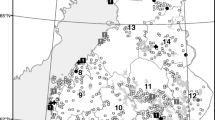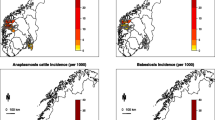Abstract
A tick-borne encephalitis virus focus was identified in a former goat pasture that had been associated with a milk-borne encephalitis outbreak in 2007. Ticks and rodents were sampled monthly from April 2010 to October 2013 on two separate 0.5 ha sampling sites. At site 1, three tick-borne encephalitis virus strains were isolated from a total of 7,247 sampled ticks; 28 of the 539 tested sera (5.19%) were seropositive. At site 2, from the 2,369 sampled ticks, virus was not isolated, tests of 284 rodent sera resulted in 14 positives (4.93%). For survival, the virus needs a territory with continuously dense rodent and tick population, although observed TBEV prevalence was low both in ticks and in rodents. Sampling points of positive ticks and rodents did not coincided exactly, at a certain time only some m2 territory is dangerous, these hot spots change unpredictably as positive ticks die or move on with their hosts.



Similar content being viewed by others
References
Alekseev AN, Chunikhin SP (1990) The exchange of the tick-borne encephalitis virus between ixodid ticks feeding jointly on animals with a subthresold level of viremia. Meditsinskaia Parazitologiia i Parazitarnye Bolezni (2):48-50. Russian
Amato-Gauci AJ, Zeller H (2012) Tick-borne encephalitis joins the diseases under surveillance in the European Union. Eurosurveillance 17:42. http://www.eurosurveillance.org/ViewArticle.aspx?ArticleId=20299. Accessed January 30, 2014
Balogh Zs, Ferenczi E, Szeles K, Stefanoff P, Gut W, Szomor KN, Takacs M, Berencsi Gy (2010) Tick-borne encephalitis outbreak in Hungary due to consumption of raw goat milk. Journal of Virological Methods 163(2):481-485
Daniel M, Danielová V, Křiž B, Beneš Č (2002) Tick-borne encephalitis. In: Climate Change and Adaptation Strategies for Human Health, Menne B, Ebi KL (editors), Darmstadt, Germany: Steinkopff, pp 189-205
Donoso Mantke O, Escadafal C, Niedrig M, Pfeffer M, On behalf of the Working group for Tick-borne encephalitis virus (2011) Tick-borne encephalitis in Europe, 2007 to 2009. Eurosurveillance 16(39):a003772. http://www.eurosurveillance.org/ViewArticle.aspx?ArticleId=19976. Accessed January 30, 2014
Fomsgaard A, Fertner ME, Essbaurer S, Nielsen AY, Frey S, Lindblom P, Lindgren PE, Bdker R, Weidmann M, Dobler G (2013) Tick-borne encephalitis virus, Zealand, Denmark, 2011. Emerging Infectious Diseases 19(7):1171-1173
Gannon WL, Sikes RS and The Animal Care And Use Committee Of The American Society Of Mammalogists (2007) Guidelines of the American Society of Mammalogists for the use of wild mammals in research. Journal of Mammalogy 88(3):809-823
Jääskeläinen AE, Tikkakoski T, Uzcátegui NY, Alekseev AN, Vaheri A, Vapalahti O (2006) Siberian subtype tickborne encephalitis virus, Finland. Emerging Infectious Diseases 12(10):1568-1571
Kislenko GS, Korotkov IuS, Chunikhin SP, Karavanov AS (1993) [An attempt at the serological examination of small mammals in a natural focus of tick-borne encephalitis in central Siberia.] Meditsinskaia Parazitologiia i Parazitarnye Bolezni (3):34-38. Russian
Kožuch O, Grešíková M, Nosek J, Lichard M, Sekeyová M (1967) The role of small rodents and hedgehogs in a natural focus of tick-borne encephalitis. Bulletin of the World Health Organization 36 Suppl 1:61-66
Labuda M, Randolph SE (1999) Survival strategy of tick-borne encephalitis virus: cellular basis and environmental determinants. Zentralblatt für Bacteriologie 289(5-7):513-524
Leonova GN, Maĭstrovskaia OS (1996) [Viremia in patients with tick-borne encephalitis and in persons with attached Ixodes ticks.] Voprosy Virusologii 41(5):224-228. Russian
Lindgren E, Jaenson TGT (2002) Lyme borreliosis in Europe: Influences of climate change, epidemiology, ecology and adaptation measures. In: Climate Change and Adaptation Strategies for Human Health, Menne B, Ebi KL (editors), Darmstadt, Germany: Steinkopff Verlag, pp 157-188
Lindquist L, Vapalahti O (2008) Tick-borne encephalitis. Lancet 371(9627):1861-1871
Mansfield KL, Johnson N, Phipps LP, Stephenson JR, Fooks AR, Solomon T (2009) Tick-borne encephalitis virus – a review of an emerging zoonosis. Journal of General Virology 90:1781-1794
Molnár E (1979) Distribution and public health significance of tick-borne encephalitis and other arboviruses in Hungary. Dissertation, Hungarian Academy of Sciences, Budapest
Pavlovsky EN (1966) Natural Nidality of Transmissible Diseases with Special Reference to the Landscape Epidemiology of Zooanthroponoses, Urbana and London: University of Illinois Press
Pukhovskaia NM, Dolgikh AM, Vereta LA, Pletnev AG (1991) [Natural foci of tick-borne encephalitis on the southwestern coast of Sakhalin.] Meditsinskaia Parazitologiia i Parazitarnye Bolezni (2):48-50. Russian
Radda A (1988) [A natural focus of early summer meningoencephalitis virus in Tyrol.] Zentralblatt für Bakteriologie, Mikrobiologie und Hygiene. Series A: Medical Microbiology, Infectious Diseases, Virology, Parasitology 267(4):570-575. German
Süss J (2008) Tick-borne encephalitis in Europe and beyond—the epidemiological situation as of 2007. Eurosurveillance. 13(26):717–727. http://www.eurosurveillance.org/ViewArticle.aspx?ArticleId=18916. Accessed January 30, 2014
Süss J (2011) Tick-borne encephalitis 2010: Epidemiology, risk areas, and virus strains in Europe and Asia: An overview. Ticks and Tick-borne Diseases 2(1):2-15
Süss J, Sinnecker H, Sinnecker R, Berndt D, Zilske E, Dedek G, Apitzsch L (1992) Epidemiology and ecology of tick-borne encephalitis in the eastern part of Germany between 1960 and 1990 and studies on the dynamics of a natural focus of tick-borne encephalitis. Zentralblatt für Bakteriologie 277(2):224-235
Acknowledgments
The study was financed by the Hungarian National Research Grant OTKA K 81258 and K 103937. We thank Szabolcs Ádámszki, Balázs Markó and Gyula Takács for their work on the field, and for family Rákóczi for the wide variety of support in field work. The authors would like to thank Ágnes Hajdu for many useful discussions and critical reading of the manuscript.
Author information
Authors and Affiliations
Corresponding author
Rights and permissions
About this article
Cite this article
Zöldi, V., Papp, T., Rigó, K. et al. A 4-Year Study of a Natural Tick-Borne Encephalitis Virus Focus in Hungary, 2010–2013. EcoHealth 12, 174–182 (2015). https://doi.org/10.1007/s10393-014-0969-0
Received:
Revised:
Accepted:
Published:
Issue Date:
DOI: https://doi.org/10.1007/s10393-014-0969-0




